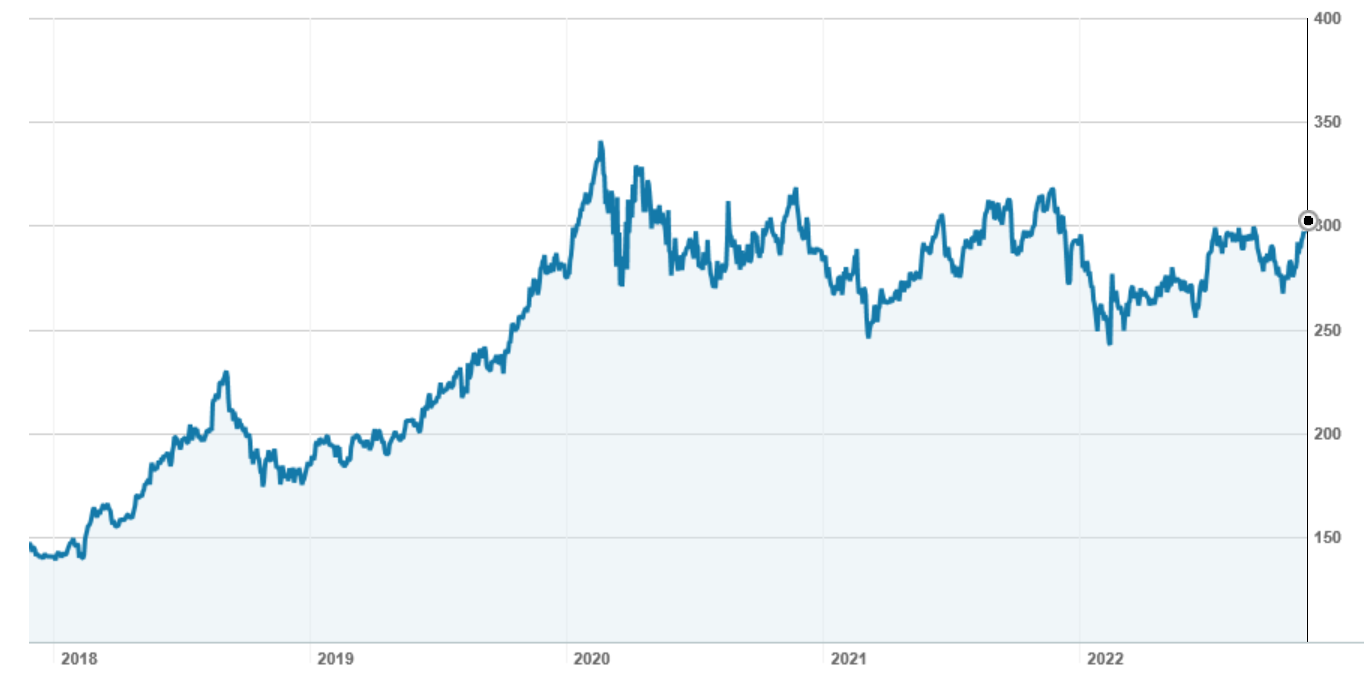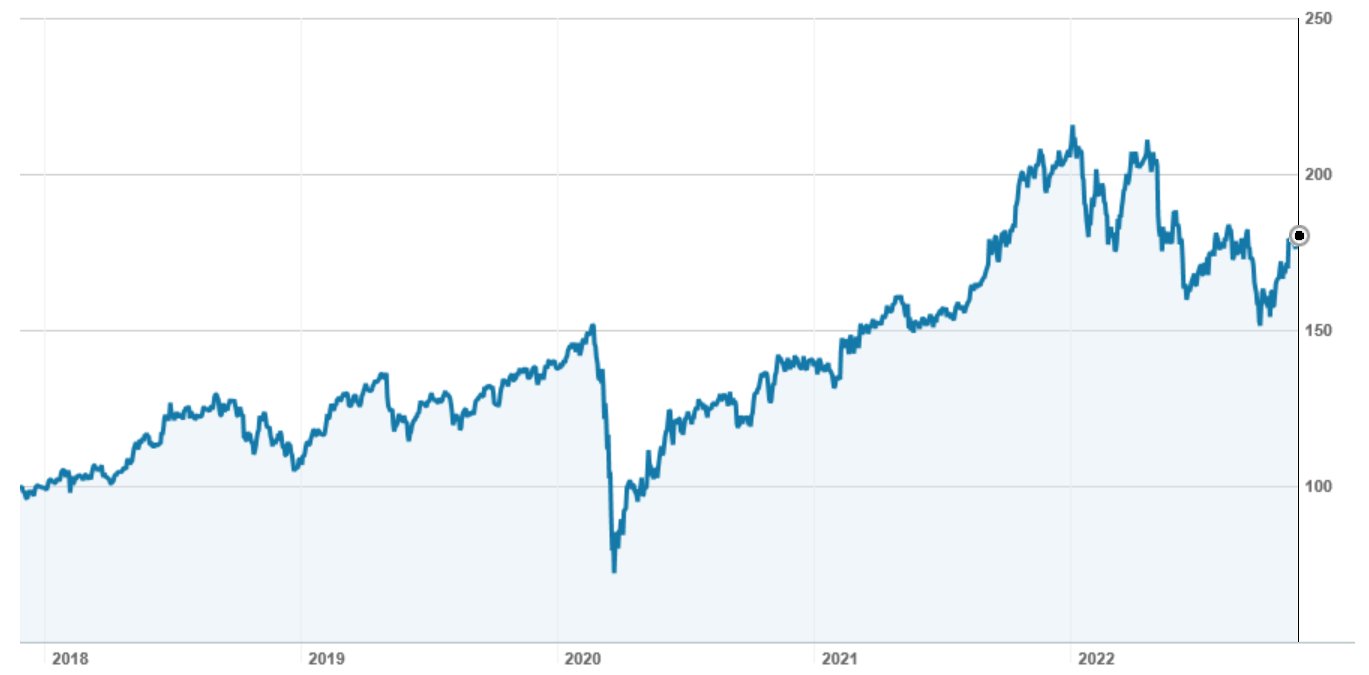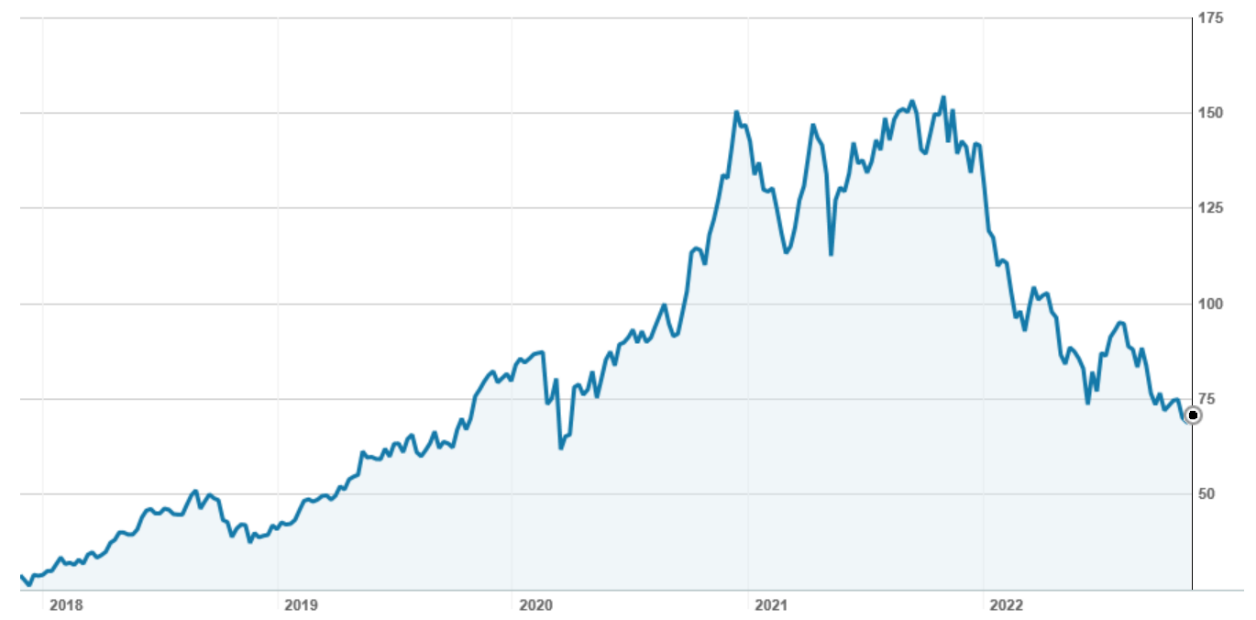Security Alert: Scam Text Messages
We’re aware that some nabtrade clients have received text messages claiming to be from [nabtrade securities], asking them to click a link to remove restrictions on their nabtrade account. Please be aware this is likely a scam. Do not click on any links in these messages. nabtrade will never ask you to click on a link via a text message to verify or unlock your account.
The top three stocks for 2023
If the market pundits are to be believed, there is an increasing consensus that inflation in the US has peaked and interest rate increases are nearing an end. The test for this assumption will probably come on December 13 when data for the US November Consumer Price Index is released. The following day, the US Federal Reserve will announce any change to the Federal Funds rate.
While the Reserve Bank of Australia will retain its own independent stance and consider Australian interest rates in light of Australian inflation, it is so much a global issue that when the lead market says that rates have peaked, we are sure to be a fast follower. The idea that interest rate increases are over and that in the medium term, the next big move is down, should be a positive for most stocks.
Here are my top three picks for 2023. While they are not necessarily exposed to higher interest rates, because they are on higher multiples or are viewed as ‘growth’ stocks, if interest rates keep rising, they will struggle. If the market instead looks forward to a medium term decline in rates, they should be winners.
1. CSL
CSL is one of my favourite stocks. It has been struggling to crack the “$300” mark as the chart below shows. It has held up well, but as a “high” multiple stock with growth focus, not been “top of mind” for investors over the last 12 months.
CSL – 11/17 to 11/22

Source: nabtrade
CLS is of course Australia’s leading health care stock. It is a global leader, with more than 90% of its revenues coming from outside Australia. It is number one in blood plasma products, number two in influenza vaccines and following its acquisition of Vifor Pharma (now known as CSL Vifor), a global leader in the treatment of iron deficiency and anaemia from kidney disease.
The thing I like most about CSL is that it has a history of surprising on the upside. Broadly, delivering ahead of profit guidance and market expectations. Moreover, it is supported by the tailwinds of an ageing population and improving medical technology (which lead to an increasing demand for medical services), plus funding from governments for medical services growing at a rate above long run inflation.
Reported profit for FY22 of US$2,236m was down 6% in constant currency terms on FY21, but near the top of earlier company guidance of in the range of US$2,150m to US$2,250m. Revenue was up 3% largely due to the outstanding performance of CSL Seqirus (the influenza vaccines business), where revenue rose by 13%. In the larger CSL Behring business which is immunoglobulins and albumin (from blood plasma), haemophilia and other specialty products, revenue rose by 2%. Higher blood plasma collection costs, plus constrained collections due to the impact of Covid, led to the fall in NPAT.
Plasma, which is sourced through collection centres in major cities (mainly in the USA), is now back at pre-pandemic levels. During the pandemic, many donors elected to remain at home. CSL was also required to take additional pre-cautions for the safety of donors. With around a nine month lead time between the collection of the blood plasma and product sale, this is a key driver of future revenue (and profitability). CSL opened 27 plasma collection centres in FY22 and is investing in a new plasmaphereses platform which will deliver a 30% improvement in collection times.
Two key products not dependent on blood plasma, IDELVION (which is a recombinant haemophilia B product), and KCENTRA (used for peri-operative bleeding), grew sales by 20% and 18% respectively. The latter as hospital demand returned to pre-pandemic levels.
Looking ahead, CSL has guided to the following for FY23:
- Revenue growth of 7% to 11% at constant currency
- NPAT of US$2,400 to US$2,500m at constant currency (growth of 7.3% to 11.8%). With CSL Vifor included (the acquisition was completed in August 2022), this has been upgraded to a range of US$2,700m to US$2,800m.
The brokers are bullish on CSL. Of the six major brokers covered by FN Arena, each has a “buy” recommendation. The consensus target price is $327.03, 9.1% higher than the last ASX price of $299.72. The range is a low of $310.00 through to a high of $343.00.
On multiples of forecast earnings, the brokers have CSL trading on a (consensus) multiple of 36.8 times forecast FY23 earnings (using current exchange rates) and 29.5x forecast FY24 earnings.
2. Macquarie Group (MQG)
Trading comfortably over $200.00 at the start of the year, Macquarie has eased in price as investors fear that higher interest rates will impact its market facing businesses.
Macquarie Group (MQG) – Nov 17 to Nov 22

Source: nabtrade
But Macquarie’s half year profit result (1H23) (announced in late October) re-confirmed why it’s a great company. The profit of $2,305m, up 13% on the corresponding half in FY22, was a clear beat on analysts’ forecasts which were in the $2.0bn - $2.1bn range. More impressively, 72% of Macquarie’s income was generated offshore.
Macquarie has four operating divisions. Banking & Financial Services (BFS), which competes with the local Australian banks and provides home loans, business loans and wealth management services; Macquarie Asset Management (MAM) – a global specialist asset manager with almost $800bn in funds under management in fields as diverse as infrastructure, green investment, agriculture, fixed income and real estate; Commodities & Global Markets (CGM); a global business in trading and financial risk management; and Macquarie Capital (MC), a global business in advisory, capital raisings and equities broking.
The first two business units, BFS and MAM, are considered by Macquarie to be “annuity style businesses”, while the latter two, CGM and MC, are “market facing” businesses. In 1H23, the profit split between the annuity and market facing businesses was exactly 50%/50%.
That’s not to say that there isn’t volatility in the earnings of Macquarie Asset Management (MAM). While base management fees are fairly predictable, performance fees aren’t. Further, MAM also books considerable income from the divestment of assets, so the timing of these events can have a big impact on profit from one half to the next. In the first half, MAM was responsible for 31% of Macquarie’s profit.
Earnings from Commodities & Global Markets (CGM) and Macquarie Capital (MC) are also volatile, with a dependency on market conditions. In the first half, CGM was again the star. It was responsible for 37% of the Group’s profit, with profit up 15% on 1H22.
BFS generated 13% of group profit. It saw its home loan book rise to $101bn and deposits grow by $18.7bn to $122.0bn. Interestingly, in the 6 months to 30 September, Macquarie grew its home loan book by $11.5bn whilst ANZ grew its book by only $4.7bn.
Looking ahead, Management outlined a cautious stance. While the smaller BFS should be a winner from higher margins and business growth, MAM will be challenged by the non-repeat of the realisation of investment gains. Lower transaction activity is expected to impact Macquarie Capital. Forecasting for the powerhouse Commodities and Global Markets division is difficult, but that said, management appeared to be a little more upbeat.
Macquarie has a history of being conservative with its forecast and outlook statement, and then delivering a positive surprise when it announces its earnings. This profit result was another example of “surprising on the upside”. So while Macquarie’s caution shouldn’t be dismissed, it does need to be seen in the context of an organisation that places a premium on risk management.
CEO Shemara Wikramanayake concluded her ASX release with this statement:
“Macquarie is well positioned to deliver superior performance in the medium term. This is due to our deep expertise in major markets; strength in business and geographic diversity and ability to adapt the portfolio mix to changing market conditions; an ongoing program to identify cost saving initiatives and efficiency; ongoing technology spend across the Group; a strong and conservative balance sheet; and a proven risk management framework and culture”.
Shareholders were rewarded with an interim dividend of $3.00 per share (franked to 40%), up from last year’s interim of $2.72, and representing a payout ratio of 50%. While at the bottom of Macquarie’s payout range of 50% to 70%, it is consistent with Macquarie’s historical approach to the interim dividend.
The brokers are largely positive on Macquarie. Cautious in regard to short term headwinds, but positive in regard to long term prospects. Of the six major brokers covered by FN Arena, there are four “buy” recommendations, 1 “neutral” recommendation and 1 “sell” recommendation. The consensus target price is $189.88, 9.1% higher than the last ASX price of $177.95. The range is a low of $150.00 through to a high of $215.00.
On multiples of forecast earnings, the brokers have Macquarie trading on a (consensus) multiple of 16.0 times forecast FY23 earnings and FY24 earnings.
3. Xero
Cloud accounting software provider Xero (XRO) has shed more than 50% since the start of 2021 from $141.44 to $69.05. It has been a victim of the downgrade of high growth technology stocks.
It has also not delivered as well as hoped for in key growth markets outside Australasia (chiefly the UK and USA), so a portion of the fall represents investor disappointment with this outcome.
Xero (XRO) – Nov 17 to Nov 22

Source: nabtrade
Two weeks’ back, it reported its first half result to 30 September (Xero has a financial year that ends on 31 March). It added a net 225,000 subscribers in the first half of FY23, down from 272,000 subscribers of the corresponding half of FY22. This took the total number of subscribers to 3.5 million. However, Australia/NZ accounted for 67% of the growth, up from 58%, and the USA/UK only yielded 26% of the growth. Xero said that the subdued economic outlook in the UK and the timing of a VAT change impacted performance there.
CEO Steve Vamos is stepping down. His replacement is Silicon Valley and former Google Executive, Sukhinder Singh Cassidy. She will formally take over on 1 February and is expected to be based in Northern California.
There were several positives in the half year result, including key SaaS (software as a service) metrics. These included:
- Total lifetime value of customers increased by 30% from NZ$9.9bn to NZS13.0bn;
- Churn stayed very low at 0.91% (up very marginally from 0.88%);
- Average revenue per user (ARPU) increased by 13% from NZ$31.32 per month to NZ$35.30. In constant currency terms, the increase was 6%.
Financially, EBITDA increased by 11% from NZ$98m to NZ$109m, and free cash flow from NZ$6m to $NZ15m. Operating expenses as a percentage of revenue rose marginally from 83.4% to 83.9%.
Looking ahead, Xero said that full year operating expenses should be at the lower end of a range of 80-85%. This implies that EBITDA and free cash flow generation in the second half will be higher than the first half.
The brokers are largely positive on Xero. Of the six major brokers covered by FN Arena, there are four “buy” recommendations, and 2 “sell” recommendations. The consensus target price is $85.24, 23.4% higher than the last ASX price of $69.05. The range is a low of $70.00 through to a high of $106.80.
At around a multiple of 9 times EV/Revenue (enterprise value to revenue), Xero is towards the higher end of global SaaS companies. Profitable growth is the key to sustaining a high multiple, so Xero’s success in the US and UK markets is critical.
Xero has been incredibly successful in Australasia, where it has It has demonstrated, high customer satisfaction, low churn and the ability to increase revenue per customer. I think it can do the same in the UK and USA, which are huge markets and arguably behind Australasia in terms of the provision of accounting software services to small businesses.
A material improvement in share price will only come when it can demonstrate improved traction offshore, and/or the market globally re-rates SaaS technology companies.
All prices and analysis at 28 November 2022. This information was produced by Switzer Financial Group Pty Ltd (ABN 24 112 294 649), which is an Australian Financial Services Licensee (Licence No. 286 531This material is intended to provide general advice only. It has been prepared without having regard to or taking into account any particular investor’s objectives, financial situation and/or needs. All investors should therefore consider the appropriateness of the advice, in light of their own objectives, financial situation and/or needs, before acting on the advice. This article does not reflect the views of WealthHub Securities Limited.
